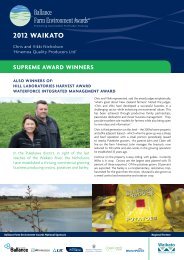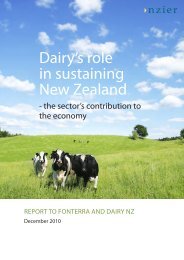NZIER report on compensation for transmission infrastructure
NZIER report on compensation for transmission infrastructure
NZIER report on compensation for transmission infrastructure
You also want an ePaper? Increase the reach of your titles
YUMPU automatically turns print PDFs into web optimized ePapers that Google loves.
the cost of driving around support structures and maintaining uncultivated space<br />
(Hydro-Québec 2000). Operati<strong>on</strong>al costs include compensati<strong>on</strong> <strong>for</strong> restricti<strong>on</strong>s <strong>on</strong><br />
development within proximity of the transmissi<strong>on</strong> <strong>infrastructure</strong>, c<strong>on</strong>sidered by Hamer<br />
and O‟Brien (2007), to be the single largest impositi<strong>on</strong> of such <strong>infrastructure</strong>.<br />
In most of the cases we looked at (Australia, Canada, Finland, New Zealand and the<br />
United Kingdom) operati<strong>on</strong>al costs resulting from transmissi<strong>on</strong> <strong>infrastructure</strong> are<br />
calculated and compensated <strong>for</strong> (see, <strong>for</strong> example, Hamer and O‟Brien 2007).<br />
Operati<strong>on</strong>al costs are more of a c<strong>on</strong>cern to landowners than the <strong>infrastructure</strong>s‟<br />
effect <strong>on</strong> land values. Solum <str<strong>on</strong>g>report</str<strong>on</strong>g>s the findings from a mid 1980s survey of 180<br />
landowners in Wisc<strong>on</strong>sin with transmissi<strong>on</strong> <strong>infrastructure</strong> <strong>on</strong> their land (including 127<br />
agricultural landowners). The survey found that more agricultural landowners were<br />
c<strong>on</strong>cerned about the costs imposed by the <strong>infrastructure</strong> hindering farming<br />
operati<strong>on</strong>s than <strong>on</strong> decreasing property value (Solum 1985). This is to be expected<br />
given the change to land value is <strong>on</strong>ly realised if a property is sold and hence will be<br />
discounted, whereas operati<strong>on</strong>al costs are current.<br />
In some cases, operati<strong>on</strong>al cost compensati<strong>on</strong> recognises that when <strong>infrastructure</strong> is<br />
spaced close together it places greater restricti<strong>on</strong>s <strong>on</strong> farming operati<strong>on</strong>s. The UK‟s<br />
Nati<strong>on</strong>al Grid‟s compensati<strong>on</strong> increases by 50 percent when the supports of two<br />
separate electricity lines are within 30 metres of each other (Hamer and O‟Brien<br />
2007). Hydro-Québec allows <strong>for</strong> an increment of 50 percent over and above 100<br />
percent of market value compensati<strong>on</strong> “in c<strong>on</strong>siderati<strong>on</strong> of the small surface area<br />
used” (Hydro-Québec 2000 pg 64). Beesley points out how cost to the landowner is,<br />
in part, a functi<strong>on</strong> of how the transmissi<strong>on</strong> <strong>infrastructure</strong> is installed over the land.<br />
The author suggests additi<strong>on</strong>al compensati<strong>on</strong> may be needed when, <strong>for</strong> example,<br />
lines dissect productive land diag<strong>on</strong>ally increasing the time cost of working land<br />
(Beesley 2008).<br />
There appears to be a large degree of c<strong>on</strong>sensus <strong>on</strong> the factors which are<br />
c<strong>on</strong>sidered as causing additi<strong>on</strong>al operating costs. Exactly how compensati<strong>on</strong> is<br />
calculated, however, is not clear in the literature. From what we can gather<br />
operati<strong>on</strong>al costs are generally based <strong>on</strong> additi<strong>on</strong>al cost estimates as provided by<br />
industry experts.<br />
3.4.5 Externalities<br />
There were two negative externalities from transmissi<strong>on</strong> <strong>infrastructure</strong> comm<strong>on</strong>ly<br />
discussed in the literature; the aesthetic impact of <strong>infrastructure</strong>, and the perceived<br />
effect of transmissi<strong>on</strong> lines <strong>on</strong> health through Electro Magnetic Fields (EMFs). A<br />
number of authors thought that these externalities should be compensated <strong>for</strong><br />
(Beesley 2008; Hutchis<strong>on</strong> and Rowan-Robins<strong>on</strong> 2000). In some countries (<strong>for</strong><br />
example, Australia, Finland and the United Kingdom) payment appears to be in part<br />
intended to compensate landowners <strong>for</strong> their loss from externalities (see, <strong>for</strong><br />
example, Hamer and O‟Brien 2007). Although how externalities were priced was not<br />
<str<strong>on</strong>g>NZIER</str<strong>on</strong>g> – Compensati<strong>on</strong> <strong>for</strong> transmissi<strong>on</strong> <strong>infrastructure</strong> 22
















